OR/15/019 Pilot study results
| Bonsor H C1, Oates N2, Chilton P J1, Carter R C3, Casey V3, MacDonald A M1, Calow R2, Alowo R4, Wilson P1, Tumutungire M5, Bennie M5. 2015. A Hidden Crisis: strengthening the evidence base on the sustainability of rural groundwater supplies – results from a pilot study in Uganda. British Geological Survey Internal Report, OR/15/019. 1BGS Edinburgh, 2ODI London, 3Wateraid UK, 4Wateraid Uganda, 5Makerere University |
Community surveys
The main findings from the community surveys are summarised below. The results include all 24 water points covered by the surveys.
Water demand
Village populations ranged between 200 and 1260 people (averaging around 670) whilst the number of households ranged from 47 to 365 (averaging around 130), giving some indication of demand for water in each community, as well as the significant variation in community size.
The survey showed that communities collect water from a number of sources, both improved and unimproved sources, for different purposes. Boreholes with handpumps were the predominant type of improved sources available in villages surveyed and generally preferred over unimproved sources for drinking, and were used for cooking, bathing, washing and livelihood activities as well, depending on the availability and convenience of other water sources in the community.
Failure of water points (i.e. boreholes) in the community and in neighbouring villages was reported to place increased pressure on remaining water points, which were sometimes shared by several villages, and long queues were frequently reported.
Water point planning, siting and construction
The extent to which communities were consulted and/or participated in different stages of the planning processes for the water point in question varied considerably. Ideally a water point is developed because a community has expressed a demand or need for the intervention. This was true for at least two thirds of our sample. In most of these cases the community (or local school) had submitted a written request to the District Water Office (DWO) which was either honoured or passed on to an NGO. Another indicator of demand is willingness to pay. Four communities said they had contributed to capital costs (co‐funding construction), typically paying 200 000 UGX (75 USD). One community (K13) was told to contribute towards construction but the borehole broke down before they had paid. Recurrent finance is discussed below. For six water points there was a Memorandum of Understanding (MoU) signed by the implementing agency and community, sometimes including the land owner. However, it did not appear that these MoUs had been an effective means of holding the relevant agency to account when the water point failed.
A good siting process would factor in both community preferences (needs) and technical suitability to ensure that the borehole was both accessible and productive. It is difficult to ascertain the technical details of the siting process from community discussions and unfortunately it was not possible to seek out the relevant experts in the time available. In all cases a survey of some kind was undertaken, but it was not always clear how extensive these surveys were or what kind of equipment was used. Some communities were entirely absent from the survey process (e.g. A5, A8, K10), most were involved to some extent, whilst a few clearly played a very active role in proposing and shortlisting potential sites (such as A1 and K1). In many cases, based on the data available, it was difficult to determine the rationale behind the selection of a particular site. In K5, for instance, the community were not involved in site selection and also claimed that the drillers did not construct the water point at the location selected by the surveyors.
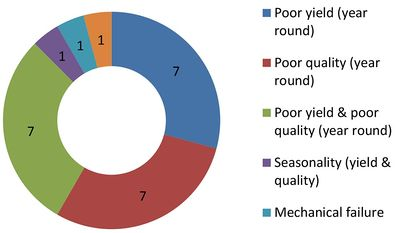
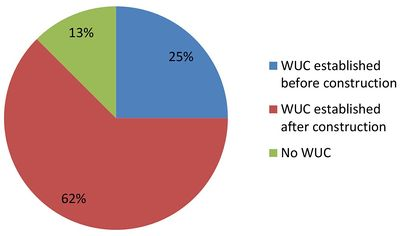
The community survey data indicated that water point construction was rarely supervised properly, if at all. Ideally a technical expert such as a hydrogeologist or engineer would be present throughout the process. At two sites a non‐technical expert from the local NGO was supervising throughout. In six other cases there were spot checks during construction by the DWO or NGO. Communities felt unable to judge quality of construction work or materials used and were generally poorly informed about the siting and drilling process.
Water quality and yield
According to the community discussions, many of the water points surveyed had quality and/or yield problems from the start, indicating an issue with siting or construction. Only three or four were functioning for one year or more before problems arose. Poor yield manifested itself in difficulties with pumping and/or having to rest the pump, whilst quality was primarily determined by sight (e.g. milky or rusty colour, presence of ‘worms’ or particles in the water), smell and/or taste. In five cases samples of the water had been taken away by local experts for testing at the time of the community complaints, but only one community had received feedback. There were few cases of seasonal failure (K12, A20) (see Figure 10).
Access to the water point
Half of the failed water points surveyed had fixed opening hours, primarily to enable supervision by the caretaker, whilst the remainder were open at all times. In general there were no restrictions on what the water could be used for or how much could be taken, but in some cases access was limited by other factors such as convenience (relative to other water sources) or borehole yield. In two cases it was agreed to limit the number of jerry cans of water taken by each household to allow everyone to collect water. At K12 this applied only during the dry season whilst at K3 the borehole was low yielding. All community members (and even households from other villages) were eligible to use the water points surveyed, provided they had paid their user fees and adhered to other by‐laws, although in some cases there were difficulties enforcing these rules (discussed below). In one case (K2) water used for brick making incurred an additional fee. Where the borehole was attached to a school the students and teachers tended to take priority, particularly at busy times. In many communities the elderly or disabled were given priority and assistance at the water point.
Often the failure of the water point has meant that people have to travel further to draw water from an improved source or resort to unimproved sources.
Community management of the water point
The data showed that 21 water points (~87%) had a Water User Committee (WUC) responsible for managing and maintaining the water point, enforcing by‐laws and collecting user fees, and in most cases elected by the community. Only six of these WUCs were formed before water point construction, allowing their participation in the planning process. Of the three water points without WUCs (13%), two were managed by the local school. See Figure 11.
Typical roles on the WUC included: chairman, secretary, caretaker, treasurer, and sometimes health or sanitation and hygiene educator. Caretakers were responsible for day‐to‐day management of the water point, including enforcement of by‐laws. Some WUCs met on a regular basis, others only when problems arose. In a couple of cases only certain members of the committee were active, usually the caretaker or chairman. WUCs became inactive when the water point was non‐functional for a significant period of time, particularly where the problem was deemed beyond the Hand Pump Mechanics’ (HPM) capacity to repair. Where communities have been affected by civil unrest, some of the older water points had been left unused (and therefore unmanaged) for several years. With the exception of four cases, communities generally appeared to be satisfied with their WUCs.
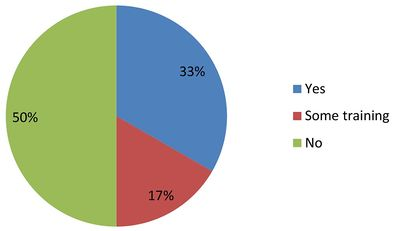
Six of the WUCs had received 2–3 days training by the implementing agency or, in one case, another NGO. Another three claimed to have received ‘some’ training, however half of the WUCs received no training at all (Figure 12). Training usually included subjects such as looking after the water point (e.g. fencing, using the pump properly), related sanitation and hygiene issues (e.g. using clean jerry cans, keeping animals away, location of latrines), and record and accounts keeping. Topics that were not covered were preventative maintenance and minor repairs (HPM’s are expected to provide this service), information regarding the potential costs of repairs, or advice on how much money to collect from users. None of the WUCs reported follow‐up training or other capacity building efforts.
By‐laws were established for all except four water points, which had failed soon after construction and/or did not have a WUC. These by‐laws related to operation, maintenance and use of the water point, for example: opening times, proper use of the pump, keeping livestock away, use of clean jerry cans, keeping the apron clean, maintaining fencing, no bathing at the water point, or sweeping the area. A few communities explicitly mentioned punishments and fines, but these were not always enforced. Ten communities reported problems in ensuring adherence to by‐laws, although the details depended on context. The most common challenge for caretakers was restricting use of the borehole, either out of hours, or in cases where households had not paid their fees.
Fees and finances for maintenance
User fees agreed by communities with their WUC varied from 200 UGX (0.08 USD) to 2000 UGX (0.75 USD) per household per month. For more than half of the sample water points covered by the community surveys there were some problems reported in collecting fees. WUCs employed a number of tactics to encourage payment, for example going door‐to‐door, confiscating jerry cans or locking the water point. The extent to which WUCs were able to collect these payments depended on a number of factors such as: the size of the payments expected, the nature of the problem (e.g. people were reluctant to pay if the water quality was bad regardless of repairs), proximity of alternative water sources, trust in the WUC, and households’ ability to pay. In most communities the elderly or disabled were exempt from contributions, and there was some flexibility where households struggled to raise the necessary finance. For example, although the WUC for K9 was strict they did allow payments to be made in instalments. Many communities were able to raise enough funds to pay for minor repairs by the HPM but few (if any) were unable to deal with the bigger/costlier problems. Fees were not collected when the borehole was non‐functional for any significant periods of time (i.e. abandoned water points).
Breakdowns, repairs and external support
HPM support and response times were generally good, although many of the problems encountered are clearly beyond HPM capacity, requiring major repairs, rehabilitation, or simply a new water point. Once the first breakdown had occurred, breakdowns thereafter tended to occur fairly regularly (every 2–3 months). Moreover, as noted above, many of these water points failed within the first few months after construction. This would indicate poor quality of parts or other underlying problems, for example relating to siting or construction.
Where there were delays to repairs these were largely attributed to difficulties the WUC faced in raising the necessary finance i.e. collecting money from community members, and therefore delays in contacting the HPM. Access to spare parts was sometimes a challenge due to the distance to the nearest sizeable town (Soroti) and associated travel costs, therefore a few communities purchased spares from the HPM or sub‐ county office. Beyond the HPMs, external support to communities was lacking. Many communities had attempted to report their problems to the DWO, another higher authority or an NGO but only a few had received a response. It is thought that the DWOs have limited human capacity or budget to cope with the scale of the problem of water point failure, although this requires further verification.
Technical investigations
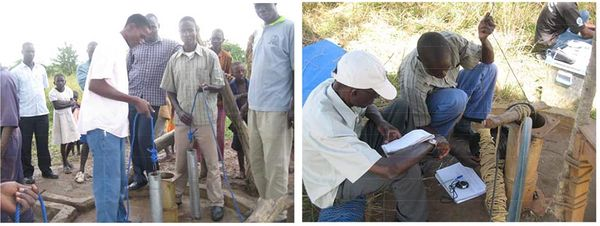
The main technical findings of the fieldwork are summarised below.
Groundwater availability and aquifer productivity
The data indicate that the crystalline Basement Complex aquifer in the region is of low groundwater potential and there can be significant variations in transmissivity of both the fractured bedrock aquifer (dependent on the number of fractures), and of the weathered overburden (dependent on the thickness and nature of the regolith). The limited availability of borehole construction records restricted understanding of this aquifer system, particularly the thickness of the regolith and how it varied in the study area. The technical field investigations were hampered because the original depths, yields, regolith thickness and water levels were not available for most sites, and the results of the fieldwork in this study could not be compared with information from the time of construction.
Pumping tests indicated the aquifer transmissivity (T) to range from 0.01 to >100 m2/d. Transmissivity measured from pumping tests in boreholes which included a screened section in the regolith aquifer ranged 0.01 to 15 m2/d. In the boreholes which entirely cased out the regolith, and in which a pumping test was possible, transmissivity was indicated to be highly variable ranging from <1 to 632 m2/d — Figure 11. At three water points transmissivity was too low to conduct a pumping test at a discharge rate of 0.5 l/s. Bailer tests at these points indicated the resource potential to be sufficient to sustainably support a hand pump. Two of these water points showed a primary symptom of failure of insufficient yield, suggesting other factors such as borehole design and construction or poor siting could be more significant to the low yield than the absolute groundwater availability. A range of borehole designs were observed, in which two cased out the weathered regolith, and one included some screen section within the regolith horizon, as discussed below.
Other work in crystalline basement complex aquifers in sub‐Saharan Africa across a range of climates has found there can be sufficient storage and transmissivity in the weathered bedrock and overlying regolith to support handpump supplies (Chilton and Smith‐Carington 1984[1]; Chilton and Foster 1995[2]; MacDonald et al. 2012[3]; Lapworth et al. 2013[4]). Based on borehole data from Malawi, Chilton and Smith‐Carington (1984)[5] concluded that the regolith aquifer would usually support borehole yields sufficient for a handpump where its saturated thickness was greater than 10–15 m, provided the borehole design was appropriate for these conditions. Appropriate targeting of borehole design relies, however, on sound understanding of the local hydrogeological conditions.
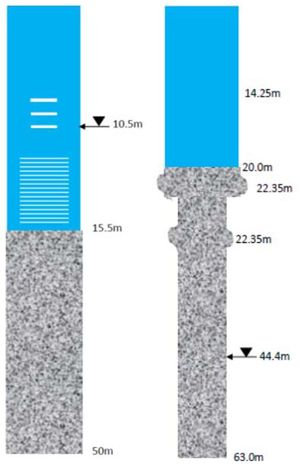
Borehole design and construction
The water points examined in the pilot study (boreholes with handpumps) were all constructed between 1997 and 2012; the majority being constructed between 2007 and 2009. Five of the boreholes have an open‐ hole design in which the weathered regolith is cased out completely and inflow to the borehole is entirely from the fractured bedrock — Figure 13. The other five have a modified open‐hole design, with the borehole being partially screened within the regolith, enabling inflow from this aquifer as well as the underlying fractured bedrock — Figure 13. In some cases, the drilling diameter in the bedrock was the same as that in the overburden, while in others a reduction in hole size is evident. All of the boreholes were cased with 5 inch (125 mm) uPVC casing, with the exception of the borehole constructed in 1997. The borehole depths ranged from 31 to 82 m (average depth 55 m). Two of the boreholes were measured as only 15 m deep, with the screened interval entirely within the weathered regolith. Siltation was apparent at the base of the boreholes, but in the absence of construction data for these it is impossible to know if the siltation has resulted in a significant reduction in the total borehole length. Significant siltation would indicate the boreholes had been inappropriately designed and/or poorly constructed and significant amounts of green‐ grey silt and fine sands have been able to enter, either through the screened sections in the regolith or around the base of the casing. Lesser amounts of siltation have probably occurred at the other sites, but could not be evaluated without knowing the original drilled depth of the boreholes. One of the boreholes was reported by the community to have partially collapsed due to inadequate installation of the casing.
In 6 of the 10 boreholes, significant inflows of water were observed in the upper 11 m section of the borehole, from the regolith and weathered bedrock — either from below the casing or through casing joints or screened intervals. In 5 of these, the shallow inflows were the only, or main, inflows observed. Half of the boreholes examined, however, cased out the regolith. Even so, if the annulus is left open and the bottom of the casing is not well sealed or seated, some water from shallower depths may pass down the outside of the casing and enter the borehole at this depth, possibly carrying fine material with it. This indicates that application of a standard borehole design leads in some cases to potentially productive aquifer horizons being cased out, and at some of the water points examined the borehole design did not match the aquifer resource.
Estimated verticality of all the boreholes examined was very good, with the maximum drift of the plumb line less than 1 mm per metre depth (or 0.1%). This is well within the guideline limit of 1% verticality to safe guard pump operation.
Groundwater quality issues were observed at all but one of the failed water points and inadequate water quality was reported by the community to be the primary symptom of water point failure at six of the supplies.

Within the exception of one water point (A16), all the abstracted groundwater contained large quantities of suspended solids, and was opaque in appearance with a pale brown to orange hue — Figure 14. In some cases, the quality improved with pumping (Figure 14), but, with the exception of one site, none of the groundwaters attained a completely transparent appearance, and remained ‘milky’ in appearance.
Well head chemistry measurements taken at the time of sampling are shown in Table 6, and indicate the groundwaters have slightly low (acidic) pH (8 of the 10 sites having pH <6.5, 4 of which are <6), moderately mineralised (measured as specific electrical conductance (SEC)) and moderately soft, with relatively low concentrations of calcium and magnesium minerals dissolved from the basement rocks into the groundwater.
Laboratory analyses of the groundwater samples taken indicate relatively high organic carbon content (material derived from decaying vegetation, bacterial growth, and metabolic activities of living organisms or chemicals), with average NPOC (Non‐Purgeable Organic Carbon — commonly referred to as total organic carbon (TOC)) measured as 0.8 mg/l (range 0.47 to 2.37 mg/l), and high dissolved iron (Fe) content — average total Fe 600 µg/l (over half of the samples had Fe in excess of 200 µg/l, with three >1000 µg/l). The high iron content in abstracted waters is supported by corrosion and staining of the pump components and by observation of significant orange staining at all the boreholes investigated in the CCTV surveys. This is most likely attributable to the high iron content of the waters, but may also be contributed to by ingress of soil particles into the boreholes which have screened intervals in the regolith (Figure 14). Elevated concentrations of zinc (five sites having Zn over 200 µg/l) are indicative of corrosion processes having taken place. Manganese concentrations were <200 µg/l in nearly all the waters. Full laboratory results are shown in Appendix 4.
| Site | Temp (°C) | SEC (µS/cm) | pH | Eh (mV) | DO (mg/l) | HCO3 (mg/l) | Estimated depth (mbgl) | RWL (mbgl) |
| A16 | 27.9 | 66.8 | 5.66 | 481 | 3.2 | 43.9 | 60 | 4.47 |
| A15 | 31.8 | 260 | 6.58 | 324 | 2.35 | 24.8 | 62 | 2.775 |
| A18 | 30.3 | 145.6 | 6.38 | 301.3 | 6.03 | 22.0 | 82 | 2.47 |
| A17 | 27.9 | 366 | 7.2 | 439.7 | 6.32 | 38.9 | 62 | 3.132 |
| A5 | 26.9 | 201 | 5.37 | 414.3 | 35.8 | 46 | 1.875 | |
| K3 | 27.4 | 152.9 | 5.66 | 386 | 5.46 | Silted to 15m | ||
| K4 | ||||||||
| K8 | 29.4 | 118.9 | 6.24 | 393.3 | 2.07 | 33.3 | 40 | |
| K13 | 29.4 | 577 | 6.10 | 305 | 0.22 | 22.5 | 52.8 | 4.68 |
| K6 | 30.2 | 376 | 5.98 | 226 | 1.09 | 12.9 | 31 | 5.47 |
| K12 | 31.5 | 315 | 6.33 | 277.6 | 3.99 | 19.2 | 52 | 3.035 |
Groundwater residence time indicators
The analysis of dissolved anthropogenic gas concentrations (CFC, SF6) indicates a difference in the ages of the waters abstracted from the water points. Half of the water points sampled are indicated to yield groundwater with a residence time less than 10 years old, whilst the other half of the water points yield groundwater which has a residence time of over 30 years old — Figure 15. This difference is most likely attributable to the difference in the borehole designs of the water points. Four out of the five samples which are indicated to have a residence time less than 10 years were from boreholes which contained a screened section within the shallow regolith. Inflows of shallow groundwater, which will be recharged from recent seasonal rainfall, will therefore inflow the borehole. These inflows were observed from the CCTVs in most cases in these boreholes.
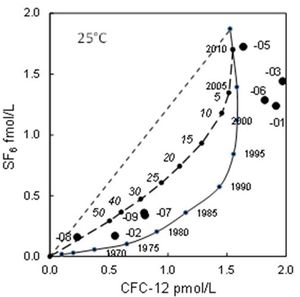
Four of the five water samples which are indicated to have a longer residence time of over 30 years, were all collected from boreholes which cased out the shallow regolith entirely, and therefore the borehole could only abstract groundwater stored within the weathered and underlying fractured bedrock.
Handpump installation and condition
All the boreholes examined were fitted with India Mark II handpumps — Appendix 2 provides an assembly drawing of this handpump. Two of the handpumps (sites K3 and A18) had serious damage to the above ground components and could not be dismantled and removed for inspection. The above and below ground components of the other water points were inspected.
Handpump installation: none of the boreholes examined had truly vertical pump stands, indicating some compromises were made to the quality of the construction and installation of the handpump. Some of the installations also used short pipe sockets, leaving the joints more prone to failure than with longer sockets. All of the handpumps used galvanised iron (GI) rising main and pipe components. There is a high risk of corrosion of GI material within certain groundwaters, leading to potential joint failure and pipe parting, perforation and leakage. Use of PVC and or stainless steel materials for handpump components has been recommended by the RUWASA Programme in Eastern Uganda for this reason, since the 1990s. Despite this recommendation, there are very few India Mark II handpump installations in Uganda which use anything other than GI rising main and pump rods.
Handpump condition: Corrosion was a serious issue in most of the handpumps examined — with only 2 out of 8 pumps which could be inspected not showing serious signs of rising main corrosion. In six of the handpumps, there was significant damage or wear to the threads of the rising main pipes due to corrosion, which in one case led to loss of the pump components down the borehole when trying to remove the pipes — Figure 16. In five of the handpumps, significant elongated perforations in the rising main were present (Figure 16).
Corrosion of the handpump materials is most likely due to use of galvanised iron in groundwater of slightly low pH. Corrosion of the GI materials will contribute to the high dissolved iron content of the water, as shown by the groundwater chemistry data in the previous section. The widespread corrosion problem indicates GI is not a suitable material for handpump installations in this region. Furthermore, in relation to the ascetic and taste acceptability of iron‐rich groundwater, the use of mild steel borehole casing and galvanised pump components can make an existing natural groundwater quality constraint significantly worse (Lewis and Chilton, 1989[6]).

Handpump repairs: All of the water points are reported by the communities to have undergone some repair during their lifetime, the most common repairs being replacement of pipes, chains and the pump cylinder. Replacement of leaking or damaged rising main pipes had occurred at 9 of the 10 handpumps. In some cases this was reported to have been done by removal of the pipes — and thereby raising the pump cylinder by approximately 3 m for each pipe removed — or, by cutting out the corroded or damaged sections of the pipes and re‐threading the remaining shorter pipes. On removal and inspection of the handpumps, there was evidence of either removal of the pipes, or shortening of pipes to remove damaged sections, rather than proper pipe replacement — Figure 17. Only one of out the 41 pumping rods examined in the nine study sites, conformed to India Mark II specifications — Figure 17.

Summary
The data from the 10 sites provide a post construction audit of the failed water points and local community governance and management arrangements. The data indicate that in some cases the borehole design does not match the aquifer resource available; handpump materials are inappropriate and possibly of poor quality; there has been a lack of supervision of the construction of water points; siting processes are often inadequate; there are problems with recurrent finance to pay for operation and maintenance due to inability or unwillingness of households to pay; in many cases there is a lack of adequate training and capacity building of Water User Committees; there have also been some challenges in community‐based management such as enforcement of rules; most communities are unable to access higher‐level support to maintain water points. All of these factors are likely to contribute, to greater or lesser extents, to water point failure. The data from the community surveys and technical investigations are brought together in the following section and analysed using the diagnostic framework and RCA approach developed by the pilot study, to see if it is possible to identify the different significance of these factors to failure and the underlying root causes.
References
- ↑ Chilton PJ & Smith‐Carington A. 1984. Characteristics of the weathered basement aquifer in relation to rural water supplies. . In: Challenges in African Hydrology and Water Resources. Proceedings of Harare Symposium, IAHS Publication 144, 57–72.
- ↑ Chilton PJ & Foster SSD. 1995. Hydrogeological characterisation and water supply potential of basement aquifers in tropical Africa. Hydrogeology Journal 3: 1, 36‐49
- ↑ MacDonald AM, Bonsor HC, Ó Dochartaigh BÉ and Taylor RG. 2012. Quantitative maps of groundwater resources in Africa. Environmental Research Letters, 7; 024009.
- ↑ Lapworth D J L. et al. 2012. Residence times of shallow groundwater in West Africa: implications for hydrogeology and resilience to future changes in climate, Hydrogeology Journal, DOI 10.1007/s10040‐012‐0925‐4
- ↑ Chilton P J & Smith‐Carington A. 1984. Characteristics of the weathered basement aquifer in relation to rural water supplies. . In: Challenges in African Hydrology and Water Resources. Proceedings of Harare Symposium, IAHS Publication 144, 57–72.
- ↑ Lewis W J and Chilton P J. 1989. The impact of plastic materials on iron levels in village groundwater supplies in Malawi. Journal of the Institution of Water and Environment Management 13 : 1, 82–88.